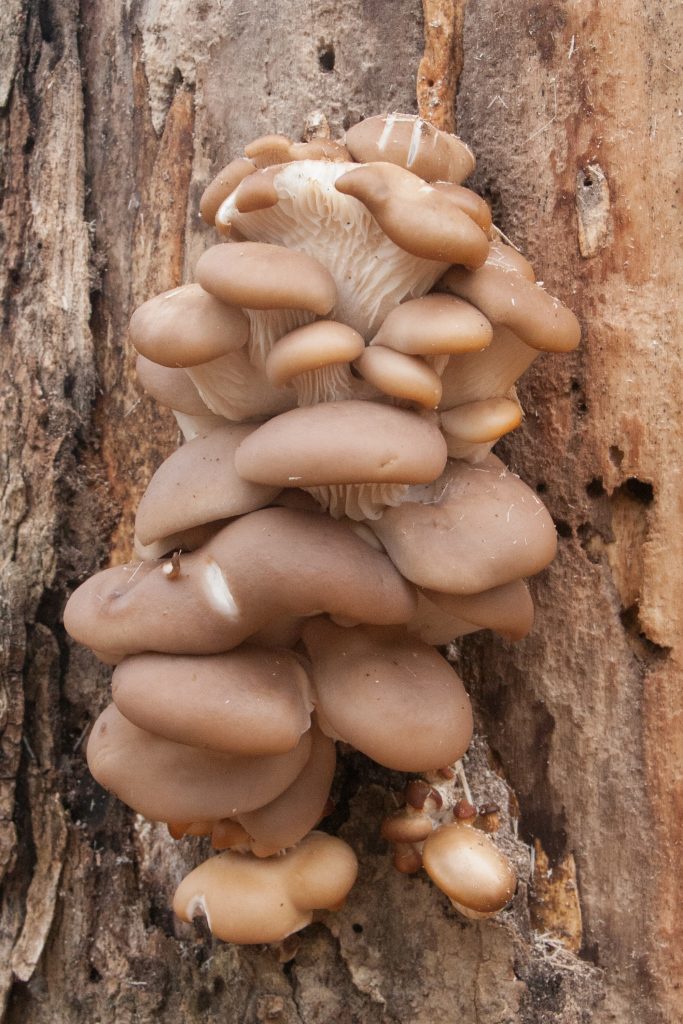
The oyster mushroom (aka Pleurotus ostreatus) is a perennial mushroom that grows in clumps on dead and dying wood. Not only is it a mild, tasty, versatile mushroom, but it has a longer harvest season than any mushroom I know. Under the right growing conditions, you can find oyster mushrooms just about year ’round, and for a temperate climate forager, that’s a beautiful thing. All hail the generous oyster mushroom!
Oysters tolerate colder temperatures than many other mushrooms and are most abundant in fall and winter. Even after a frost or two, with adequate rain you can count on oyster mushrooms for your winter table. I’ve harvested frozen oyster mushrooms in the middle of winter, then thawed and cooked them with no discernible decline in tastiness. In the Rocky Mountains, you may also find them in spring, when you’re out looking for morels.
Commercially grown oyster mushrooms are probably available in your local supermarket. Which means you can familiarize yourself with how they look before you go out and forage for them on your own. Their caps are smooth and can vary in color from off white to brown. Underneath, the gills are white and will yield a white spore print.
Oyster mushrooms have either a small or non-existent, off-center or lateral stem. You can even try growing oyster mushrooms at home with a mushroom kit.
Every time I hunt for mushrooms I ask myself the age old mushroom-hunter question: would I rather have a few, small, perfect mushrooms now, or wait for more, larger mushrooms next week (with the understanding that while I wait patiently, someone else might harvest MY mushrooms!)? Fortunately, oyster mushrooms often grow in very large clumps, so it’s not unusual to find big collections of tender, baby mushrooms. Use a knife to slice between the mushroom’s base and the bark of the tree. Check in between the gills of larger caps for bugs, then clean your mushrooms and either cook or store. To save them for later, you can dry your oyster mushrooms in a dehydrator (at 125 degrees), or, sauté them in butter or oil, then freeze.
Large, meaty oyster caps can be grilled, broiled, or fried like steaks with butter and garlic. They can also be used in all the traditional mushroom ways: soups, pastas, risottos. If the stems of your oyster harvest are a little tough, reserve them for stock or duxelles. For a tasty hors d’oeuvre or side dish, use your oysters in this mini mushroom puff.
Saw some people gathering these when I was hiking last weekend. I’m not brave enough!
Next time gather them, then save them for me!
Just found your article in a Google search! I just stumbled across a 60-foot tree covered in oyster mushrooms in New Hampshire while on a hike with my five year old, and it’s my first time finding them. We are firmly in the center of our single-digit winter and they are all frozen solid. Can I harvest them? If so, how would you go about prepping them when they’re already frozen solid? I would hate to see them turn into mush, as some of them are the size of my hand and I’m drooling thinking about an oyster mushroom burger with Swiss ????
What luck! Oysters are one of the few mushrooms that can be harvested when frozen. (I’m from NH, too, and have harvested frozen oysters there on several occasions.) When you get them home, clean them off then thaw the mushrooms you want to use for your burger. (If you have lots of extras, you can either clean and re-freeze, or just pop them directly in the freezer and clean them before you use them.) Are you planning to chop the mushrooms and form a burger, or do you want to cook them whole, like a steak?
is it safe to eat an oyster that was frozen and thawed in nature. The color, texture and smell are good. Mushrooms have the appearance of a being frozen and thawed, temperatures indicate the same. no slim or odor, just a “limp” look .
My answer is “probably”. Of course I can’t be sure without seeing it, but if it smells good with good texture and color, then it’s probably fine. You’re going to have to make your own decision, though, since I can’t see (or touch or smell) the actual specimen. I’ve done it in the past with good results.